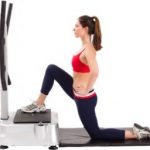Click HERE to Book Online.
The benefits of whole body vibration for osteoporosis sufferers
The benefits of whole body vibration for osteoporosis sufferers
Osteoporosis is a disease characterized by low bone mass which in turn leads to bone fragility and therefore causing the sufferer to have an increased risk of sustaining a fracture (Kanis, Melton, Christiansen, Johnston, & Khaltaev, 1994). Osteoporosis affects both men and women, however its prevalence is higher in postmenopausal women. (Eisman, Clapham & Kehoe, 2004).
The Falls Risk We Face As We Age
Thirty percent of people over sixty-five fall each year. This number increases by ten percent after age seventy-five. Muscle weakness and reduced balance are related to an increased risk of falls in elderly populations and therefore it is essential that individual with osteoporosis have sufficient strength and balance to avoid falling. (Bruyere, Wuidart, Di Palma, Gourlay, Ethgen, Richy & Reginster, 2005). Falling with osteoporosis is often disastrous and may lead to fractures. Fractures can lead to bed rest which may decrease overall health, quality of life and lead to a whole array of other issues that can be life threatening.
Exercise and Reducing Falls Risk
An increased risk of falls are linked to impaired balance and muscle weakness and therefore reducing falls in the elderly with things such as balance exercises and interventions is vital in avoiding fractures in the elderly and osteoporotic populations. (Bruyere, Wuidart, Di Palma, Gourlay, Ethgen, Richy & Reginster, 2005).
Whole Body Vibration Therapy and Bone Health
Whole body vibration therapy (WBVT) involves a vibrating platform which you stand on while completing numerous exercises. The platform oscillates back and forth at specific amplitudes/frequency. Whole body vibrations increase motor unit activity through reflex-induced muscle contraction in the lower limb (Cardinale & Lim, 2006).When our muscles are receiving vibrational stimuli from our environment, stretch reflexes in our muscles are activated and they contract in an attempt to prevent injury from overstretching. As a result, the WBVT causes all our muscles to engage at the same time increasing training efficiency. The frequency of vibrations also plays a role in what is being targeted for rehabilitation. Muscle tone, balance/stability, blood circulation and muscle power have different setting depending on what you are what your specific goals are.
The Science Behind Whole Body Vibration Therapy
Whole body vibration therapy is used to help aid in reducing pain, treating injuries, improving balance and improving performance and the body gains more awareness of its position in space and posture (Rees, Murphy & Watsford, 2008). Many studies have shown the use of WBVT increase muscle activation to a larger degree than the same activity without the use of vibration therapy (Rees, Murphy & Watsford, 2008). A randomized control trial based over a 4 month period using young, healthy, adults improved their lower extremity balance and muscle performance (Bruyere, Wuidart, Di Palma, Gourlay, Ethgen, Richy & Reginster, 2005). “In a randomized controlled trial (RCT), a 10-day whole body vibration regimen (26Hz; amplitude, 10mm; 10min/d in 2-min intervals) significantly enhanced the explosive power of the lower extremities (height of jump, mechanical power of jump) in physically active subjects” (Bruyere, Wuidart, Di Palma, Gourlay, Ethgen, Richy & Reginster, 2005).
These benefits translate to increased strength which help to prevent falls and in addition gives strength benefits for activities of daily living.Increased muscle strength and power (Verschueren, Roelants, Delecluse, Swinnen, Vanderschueren, & Boonen, 2004). Increased bone density (Blottner, Salanova, Püttmann, Schiffl, Felsenberg, Buehring & Rittweger, 2006) and improved proprioception (Moezy, Olyaei, Hadian, Razi & Faghihzadeh, 2008) are just some of the benefits of WBVT. Whole body vibration is used in combination with manual therapy and active rehabilitation to help reduce pain, increase bone density, increase muscle strength and power, improve performance, and improve balance to help reduce patient risk of falling and reduce risk of fracture with a fall and therefore is a helpful treatment for people living with osteoporosis.
Click HERE to learn more about the GALILEO and Whole Body Vibration Therapy.
Vianna Ross (MPhysio, B.A.PHEd)
Physiotherapist
References:
- Blottner, D., Salanova, M., Püttmann, B., Schiffl, G., Felsenberg, D., Buehring, B., & Rittweger, J. (2006). Human skeletal muscle structure and function preserved by vibration muscle exercise following 55 days of bed rest. European journal of applied physiology, 97(3), 261-271.
- Bruyere, O., Wuidart, M. A., Di Palma, E., Gourlay, M., Ethgen, O., Richy, F., & Reginster, J. Y. (2005). Controlled whole body vibration to decrease fall risk and improve health-related quality of life of nursing home residents. Archives of physical medicine and rehabilitation, 86(2), 303-307.
- Cardinale, M., & Lim, J. (2003). Electromyography activity of vastus lateralis muscle during whole-body vibrations of different frequencies. The Journal of Strength & Conditioning Research, 17(3), 621-624.
- Eisman, J., Clapham, S., & Kehoe, L. (2004). Osteoporosis prevalence and levels of treatment in primary care: the Australian BoneCare Study. Journal of Bone and Mineral Research, 19(12), 1969-1975.
- Kanis, J. A., Melton, L. 3., Christiansen, C., Johnston, C. C., & Khaltaev, N. (1994). The diagnosis of osteoporosis. J Bone Miner Res, 9(8), 1137-1141.
- Moezy, A., Olyaei, G., Hadian, M., Razi, M., & Faghihzadeh, S. (2008). A comparative study of whole body vibration training and conventional training on knee proprioception and postural stability after anterior cruciate ligament reconstruction. British journal of sports medicine, 42(5), 373-385.
- Rees, S. S., Murphy, A. J., & Watsford, M. L. (2008). Effects of whole-body vibration exercise on lower-extremity muscle strength and power in an older population: a randomized clinical trial. Physical therapy, 88(4), 462-470.Verschueren, S. M., Roelants, M., Delecluse, C., Swinnen, S., Vanderschueren, D., & Boonen, S. (2004). Effect of 6‐Month Whole Body Vibration Training on Hip Density, Muscle Strength, and Postural Control in Postmenopausal Women: A Randomized Controlled Pilot Study. Journal of bone and mineral research, 19(3), 352-359.







